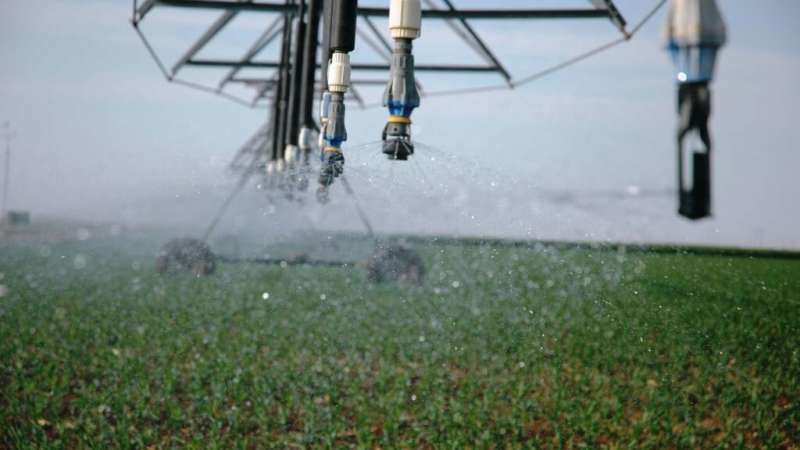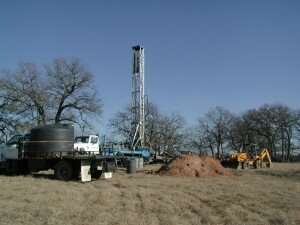A new CAST issue paper examines the long-term impact of groundwater depletion on agriculture. Credit: Texas A&M AgriLife Research photo by Kay Ledbetter
A new Council of Agricultural Science and Technology, or CAST, paper examines the causes and consequences of groundwater depletion throughout the U.S. with a focus on how this will affect agriculture—the largest sector of groundwater use.
The paper, "Aquifer Depletion and Potential Impacts on Long-term Irrigated Agricultural Productivity," was co-authored by Dr. John Tracy, Texas A&M University's Texas Water Resources Institute director, College Station.
Tracy chaired a task force of university and government researchers exploring the long-term impact of aquifer depletion on U.S. agriculture. Their investigations and insights are reflected in the paper.
Other task force members from Texas A&M included Dr. Gretchen Miller, department of civil engineering; Dr. Dana Porter, department of biological and agricultural engineering, Lubbock; and Dr. Zhuping Sheng, Texas A&M AgriLife Research and Extension Center resident director, El Paso.
Additional members included Dr. Jennifer Johnson, Bureau of Reclamation River and Reservoir Operations, Boise, Idaho; Dr. Leonard Konikow, U.S. Geological Survey, retired, Reston, Virginia; and Steve Sibray, University of Nebraska-Lincoln, Institute of Agriculture and Natural Resources.
Paper highlights include:
- An overview of groundwater and its use in the U.S.
- An outline of geographical areas impacted by groundwater use.
- Consequences from depleting aquifers.
- Mitigation efforts to reverse groundwater depletion.
- A case study on the causes, consequences and mitigation of groundwater depletion.
"Fresh water remains a critical limiting resource around the world," said Dr. David Baltensperger, head of Texas A&M's soil and crop sciences department. "This issue paper provides a great summary of issues surrounding depletion of our groundwater resource."
According to the paper, large-scale depletion of groundwater within the U.S. began in the 1950s and tripled by the 1990s, with approximately 71 percent directed toward irrigating crops, Tracy said.
"As the U.S. population increases, demands for more food production and water supplies will stress valuable water resources, especially in locations sensitive to droughts," Tracy said.
As the U.S. population increases, so will demand for fresh water. The cost of pumping will increase as the water table declines farther below the surface, and well productivity will suffer. Credit: Texas A&M AgriLife Extension Service
The paper noted the U.S. aquifer system with the greatest long-term groundwater storage depletion is the Ogallala Aquifer in the Great Plains region, where groundwater levels have declined by more than 150 feet in some areas.
"The most obvious consequences of depleting groundwater resources are the loss of a long-term water supply and the increased costs of pumping groundwater as the water table declines further below the ground surface," Tracy said.
Other consequences include reduced flow to surface water systems and ecosystems; loss of productivity of groundwater wells; subsidence of land and ground failures; and degradation of groundwater quality.
"The aquifer system is complex and dynamic, changing spatially and temporally as human activities interfere with it," Sheng said. "The depletion of groundwater might cause irreversible impacts."
Tracy stressed the long-term consequences are apparent and must be addressed carefully to avoid abusing this water resource.
"Increased competition for the use of water from aquifers may negatively affect future agricultural practices in drier regions of the U.S," Tracy said. "The problem needs to be addressed over the long haul and by avoiding promoting policies that focus on quick fixes that will ultimately fail."
Strategies to mitigate impacts of aquifer depletion may include policy, technology and management options, which should take into account local/regional conditions, including hydrogeological factors, applicability to agricultural production systems and economic factors, Porter said.
"For example, in the southern Ogallala Aquifer region, agricultural producers have adopted efficient advanced irrigation technologies such as low-pressure center-pivot irrigation systems and subsurface drip irrigation," she said. "They have also employed limited supplemental irrigation management strategies and lower-water-use crop rotations such as dryland production."
Sheng said while some solutions can be simple, such as decreasing or stopping pumping or increasing water availability with managed aquifer recharge, no one solution fits all.
"To be more effective, they should be essential components of integrated water resources management, which considers policy constraints and social and economic impacts beyond technical feasibility," he said.
More information: Aquifer Depletion and Potential Impacts on Long-term Irrigated Agricultural Productivity: www.cast-science.org/file.cfm/ … on_C4FAE917A6979.pdf
Provided by Texas A&M University
























